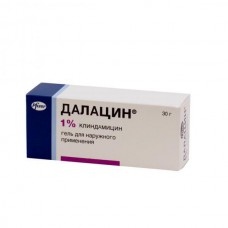Expiration date: 01/2025
Product form, composition and packaging
Gel for external use 1% in the form of transparent, colorless, viscous mass.
Auxiliary substances: allantoin-2 mg, methylparaben-3 mg, propylene glycol-50 mg, polyethylene glycol-100 mg, carbomer 934R-7.5 mg, sodium hydroxide solution 40% - q.s., purified water-q.s. until 1 propulsion 30 g-tubes (1) - packs cardboard.
1g contains: clindamycin (phosphate) 10 mg
Clinical and pharmacological group: Antibiotic for external use
Indications:
- acne vulgaris.
Dosage regimen:
Outwardly. A thin layer of gel is applied to the affected area of clean dry skin 2 times / day.
To obtain satisfactory results, treatment should be continued for 6-8 weeks, and if necessary, you can continue up to 6 months.
If, after administration of the drug for several months, the effectiveness of therapy is reduced, you should take a break in the treatment for 4 weeks.
Side effect
From the body: a burning sensation in the eyes.
From the digestive system: abdominal pain, dyspeptic disorders (diarrhea, nausea, vomiting), colitis, pseudomembranous colitis.
From the skin: most often - dry skin, skin irritation, contact dermatitis, increased production of sebaceous glands, urticaria.
Other: folliculitis caused by gram-negative flora.
Contraindications to use
- antibiotic-associated colitis history,
- age up to 12 years (data on safety and effectiveness do not exist),
- hypersensitivity to clindamycin or lincomycin history.
Application during pregnancy and breast-feeding
In animal studies with the introduction of clindamycin p / K or inside the deterioration of fertility, as well as any adverse effects on the fetus were found, except in the case of drug doses, toxic to the mother. The results of animal studies may not always be extrapolated to humans. In clinical studies, with systemic administration of the drug to women in the II and III trimesters of pregnancy, there was no increase in the frequency of congenital fetal abnormalities. Studies of the use of the drug in women in the I trimester of pregnancy was not carried out. The drug should be prescribed during pregnancy only if the expected benefit to the mother exceeds the potential risk to the fetus.
Unknown, selects whether clindamycin in breast milk after topical use. Clindamycin is found in breast milk after oral or parenteral administration, so during lactation should either cancel the drug, or stop breastfeeding, given the degree of importance of the drug for the mother.
Use in children
Do not use this medicine in children under 12 years of age (safety and efficacy data are not available).
Use in elderly patients
Clinical studies have not included a sufficient number of patients over 65 years of age to assess whether there are differences in pharmacokinetics in elderly patients compared to younger ones.
Special instruction:
Avoid contact with the drug on the mucous membrane of the eyes and mouth.
After applying the gel, wash your hands thoroughly. In case of accidental contact with sensitive surfaces (eye, abrasions on the skin, mucous membranes) should be liberally rinse the area with cool water.
The use of clindamycin (as well as other antibiotics) inside or parenterally in some cases associated with the development of severe diarrhea and pseudomembranous colitis. In the external use of clindamycin, cases of diarrhea and colitis are rare, however, caution should be exercised, and in the development of severe or prolonged diarrhea, the drug should be abolished and, if necessary, appropriate diagnostic and therapeutic measures should be taken. Usually the onset of diarrhea, colitis and pseudomembranous colitis is observed within a few weeks after the completion of oral and parenteral therapy with clindamycin. In the case of severe diarrhoea, the feasibility of colonoscopy should be decided. Appointment of drugs that reduce the motility of the gastrointestinal tract, such as opioid analgesics and Diphenoxylate with atropine, can prolong and/or worsen the course of this complication. It has been found to be effective against antibiotic-associated pseudomembranous colitis caused by Clostridium difficult. The usual dose is divided into 3-4 for adults is 500 mg to 2 g of vancomycin/day orally for 7-10 days.
Effects on ability to drive a car or operate machinery
There is no reason to believe that the use of the drug Dalacin® can influence on ability to driving a car or operate machinery.
Overdose:
Symptoms: when the local application of clindamycin may be absorbed in amounts causing systemic effects, the possible systemic side effects may include diarrhea, hemorrhagic diarrhea, including pseudomembranous colitis.
Treatment: symptomatic and supportive therapy.
Drug interaction
There is a cross resistance of microorganisms to clindamycin and lincomycin.
Was marked by antagonism between clindamycin and erythromycin.
It was found that clindamycin disrupts neuromuscular transmission and, consequently, may increase the effect of other peripheral muscle relaxants, so the drug should be used with caution in patients receiving drugs of this group.
Conditions of supply of pharmacies
The drug is allowed to use as a means of non-prescription.


